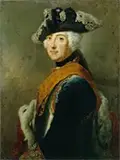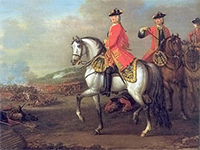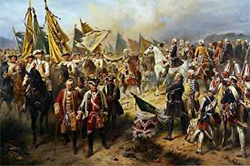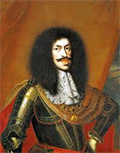The War of the Austrian Succession
So much conflict in Europe during the last few centuries of the second millennium had to do with who would rule a country. The War of the Austrian Succession had just such a cause. Into the 18th Century, the Habsburg line was in control of various European thrones. Rulers, especially, but also their subjects often found it more stable when they knew before a monarch's death who would be the next monarch. Often, it was the monarch's oldest living male child who took over the throne. If a son wasn't available, then sometimes a brother sufficed. Some monarchs were deposed and succeeded by someone entirely unrelated. Other monarchs died without a clearly defined heir. Even if a monarch defined a clear successor, that choice could be unpopular or even challenged by other The War of the Spanish Succession had consumed the major powers of Europe in the early 18th Century. The lack of a clear successor to Spain's King Charles II resulted in competing claims by France's King Louis XIV, a descendant of the Bourbon line, and Holy Roman Emperor Leopold I (left), a member of the Habsburg line. Fourteen years of fighting and three treaties later, all sides agreed that Philip, grandson of Louis XIV, would claim the Spanish throne as Philip V, provided that he gave up claims to a handful of territories.  During the latter years of that conflict, Leopold I was shoring up his own succession. In 1703, he and his sons, Joseph and Charles, had agreed to the Mutual Pact of Succession, which stipulated that if either Joseph or Charles had no son to succeed him, then the monarch would agree to pass his possessions, including the throne, to a daughter. Existing law prohibited a woman from so succeeding, so the monarchs had to get special permission from each Habsburg territory and from the Imperial Diet. 
Joseph, the older brother, who had succeeded Leopold I in 1705, died himself in 1711, and was survived by two daughters. Charles was then the last male member of the Habsburg line, since he had no male children. In 1713, Charles declared the Pragmatic Sanction, which validated the idea that his daughter or his niece could and would succeed him on the throne. Charles had no daughter, either, at this time, but the Pragmatic Sanction elevated any daughter that he might have ahead of Joseph's existing daughter in the line of succession. Most importantly, the other powers of Europe agreed that this would be the case as well. Charles's son, Leopold Joseph, was born in 1716 and lived just seven months. In 1717, Charles became a father again; his daughter, Maria Theresa (left), then became the heir to the throne. Charles died in 1740. His daughter was then in her early 20s. Not everyone agreed that she should become Empress Maria Theresa. The closest living male relative of Charles VI was his son-in-law, also named Charles, who had married Archduchess Maria Amalia, the younger daughter of Joseph I, who had ruled from 1705 to 1711. This Charles, whose full name was Charles Albert, was the Elector of Bavaria, from 1726, and saw himself as the rightful successor to the emperor. 
Another of the prime opponents of this succession was King Frederick II of Prussia (right), who had in that same year succeeded his well-known father, Frederick William I. To show his displeasure with the succession of Maria Theresa, Frederick II (later to be known as Frederick the Great) invaded Silesia, which was part of Austria. The war had officially begun. Austria had a few comrades in arms: Great Britain, the Dutch Republic, Russia, and Sardinia. Significantly, Frederick had allies as well: France, Spain, Naples, Sicily, Sweden, and the German states of Bavaria and Saxony. Treaties called for formations of these alliances. Other countries entered the war guided by opportunistic leaders. Prussia had a strong, well trained, well apportioned army, of about 80,000. The Austrian defense force was roughly twice that in number but not as well trained and was needed to defend a large amount of territory. The number of Austrian troops in Silesia at the time of the Prussian invasion was quite small. Prussian troops invaded in December, captured most of the province, and settled down for the winter. Frederick and Prussia won a quick victory when the fighting resumed, in April 1741, and France entered the war on the side of Prussia. French troops drove toward Vienna but were unable to take it. They did take Prague, however. The Elector of Bavaria, seeing opportunity, declared himself Archduke of Austria and had himself crowned the Holy Roman Emperor Charles VII in January 1742. (He was the first non-Habsburg emperor in 300 years.) At the same time, however, Austrian forces seized Munich. A series of give-and-take of territory and cities commenced, capped by a Prussian victory at Chotusitz, in May 1742. A subsequent French victory convinced Maria Theresa to sue for peace. Austria and Prussia came to terms in June 1742. The greater war, however, continued. 
The following year saw the appearance of Great Britain's monarch, George II, who led his troops into the fighting at the Battle of Dettingen, in Germany. (He was the last British monarch to do such a thing.) George was from Hanover, like his father, and so Hanoverian forces were fighting alongside English forces, who were fighting alongside Austrian forces. George II had taken a personal interest because France had targeted the Netherlands and, ostensibly, threatened Hanover. The Battle of Dettingen was a narrow victory for George II and the Austrian cause. Saxony chose this moment to change sides, throwing in its lot with Maria Theresa. Also at this time, France attempted to take advantage of the British forces' being distracted on the Continent by invading England. A storm wrecked not only the plans of the French invaders but also "Bonnie Prince Charlie", the grandson of ousted English King James II who was embarking on yet another Jacobite rebellion, an attempt to restore a Stuart to the British throne. Bonnie Prince Charlie went ahead with his own invasion of England the following year and managed to secure a great deal of support, convincing the British government to withdraw most of its forces from the Continent and install them on English soil to defend the realm. Austria and its other allies carried on the fight. In 1744, the Austrian alliance retook Prague. That didn't last long, as Frederick II gathered up nearly his entire army and moved it into Bohemia, reclaiming Prague in the process. The following year saw great French gains in the Netherlands, leaving Prussia effectively on its own, and the formation of the Quadruple Alliance (Austria, the Dutch Republic, Great Britain, and Saxony) to fight against France. 
British and French armies fought a fierce battle at Fontenoy, on May 11, 1745. British forces, led by the dynamic Duke of Cumberland, ending up leaving the field of battle in defeat, as French forces seized the fortress of Tournay. About the same time, Frederick scored a great victory over Prince Charles of Lorraine and the Austrian forces at Hohenfriedberg (left). Frederick showed off his cleverness by ordering a night march, with the army leaving their tents pitched and campfires burning and marching without talking or making any significant noise, in order to achieve maximum surprise. The Prussians did just that the following morning, catching the Austrian army while it was still encamped. The stunned Austrians lost half of their artillery and one-quarter of the army in this one battle. Charles and Austria struck back at Soor in September. A further, more devastating Prussian victory at Kesseldorf in December convinced the two sides to talk peace again. (Despite being slightly outnumbered, the Prussians killed twice as many Austrians as they lost.) In the resulting December 1745 Treaty of Dresden, Frederick II recognized Maria Theresa's right to the Austrian throne and the right of her husband, Francis, to be Holy Roman Emperor, and the new empress recognized Frederick's annexation of Silesia. The fighting still wasn't done, having raged in Italy since 1741. Spain was particularly focused on regaining territories that it had lost in its succession war and had great success early on against the forces of Austria and Sardinia. French forces soon joined Spanish forces, with the aim of occupying much of northern Italy. After the fighting against Prussia had ended, Austria was free to concentrate on fighting Spain and France in Italy. The two sides traded victories and territories for a time, with each looking like it had the upper hand once and for all only to suffer a defeat that turned the tide yet again. A joint Austria-Savoy victory at the Battle of Colle dell-Assietta in 1747 wiped out most of the French nobility and commanders and effectively ended French participation in that part of the war. A final treaty that ended all fighting was signed at Aix-la-Chappelle on Oct. 18, 1748. One of the more surprising offerings as a result of the peace negotiations was that France's new leader, King Louis XV, agreed to give up his occupation of the Austrian Netherlands. France regained control of its fortress at Louisbourg, on Cape Breton Island, in North America, in exchange for handing over Madras, in India, to Great Britain. Fighting between France, Britain, and Spain had taken place in fits and starts in the New World, where the British referred to it as King George's War. One preliminary struggle between Britain and Spain was known as the War of Jenkins' Ear. The war was fought in the Mediterranean and in the Indian Ocean as well. |
|
Social Studies for Kids
copyright 2002–2026
David White



 people within the realm.
people within the realm.
